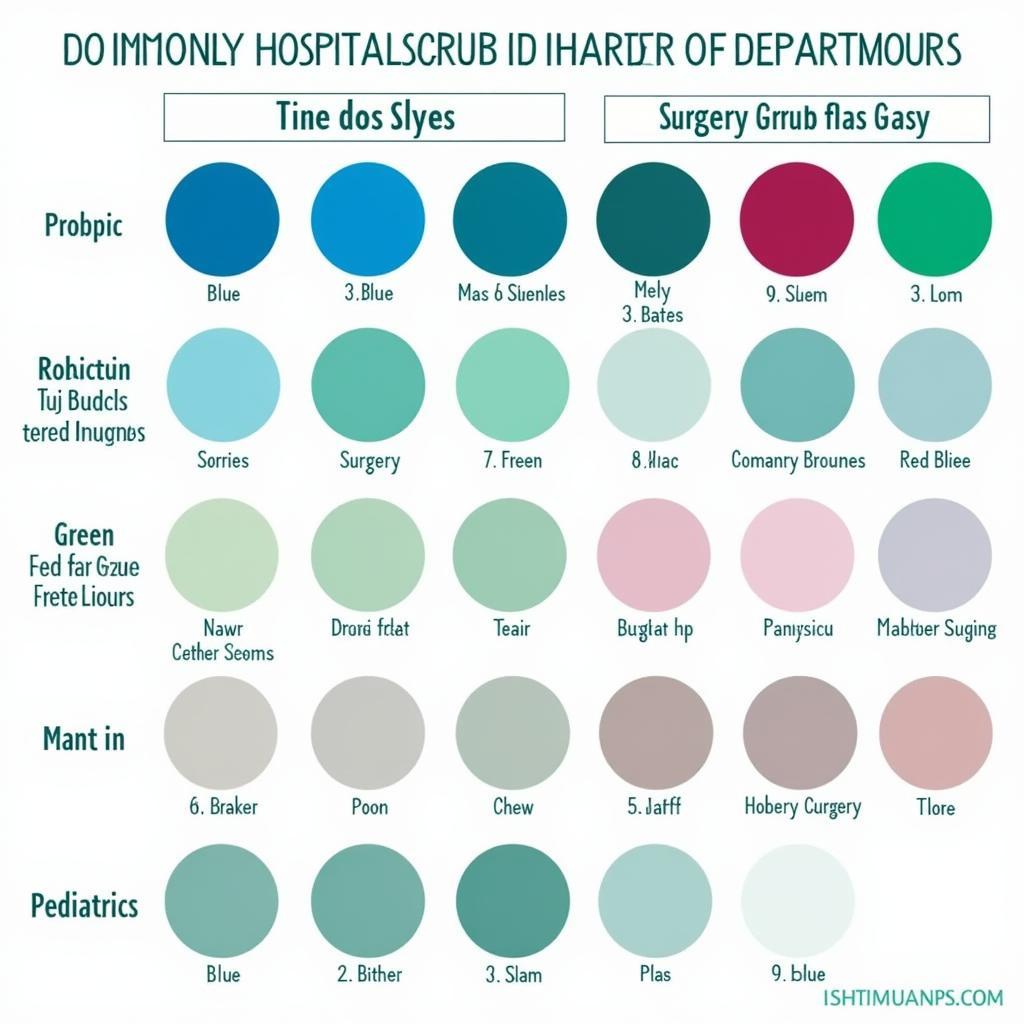Hospital scrubs colors have become an increasingly important aspect of healthcare uniforms, moving beyond mere functionality to convey meaning, professionalism, and even patient psychology. While the significance of certain colors can vary between hospitals and regions, understanding the common associations can offer valuable insights into the healthcare environment.
Decoding the Color Palette: What Do Different Scrub Colors Mean?
 Hospital Scrubs Color Chart
Hospital Scrubs Color Chart
Choosing scrub colors is rarely arbitrary. Hospitals and healthcare facilities often assign specific colors to different departments for various reasons, including:
- Patient Psychology: Colors can evoke certain emotions and responses in patients. For instance, calming colors like blue and green are often favored in stressful environments like operating rooms.
- Staff Identification: Different colored scrubs help quickly identify staff roles. This is particularly crucial in emergency situations where time is critical.
- Hygiene and Safety: Light-colored scrubs can make stains and bodily fluids more visible, ensuring prompt cleaning and minimizing contamination risks.
Common Hospital Scrubs Colors and Their Associations:
- Blue: Often associated with calmness, trust, and authority, blue is a popular choice for surgeons and operating room personnel.
- Green: Symbolizing tranquility, healing, and well-being, green is frequently worn by surgeons, nurses, and other healthcare providers, especially in pediatrics.
- Black: While less common, black scrubs might be chosen by technicians, lab personnel, or in specialized units where certain procedures require minimal light reflection.
- Grey: Similar to black, grey represents seriousness and practicality and may be preferred by those working in labs, radiology, or other technical departments.
- Red/Burgundy: These colors often signify alertness and are sometimes used in emergency departments or by those handling blood or bodily fluids.
The Impact of Scrub Color on Patient Experience
 Patient and Nurse in Green Scrubs
Patient and Nurse in Green Scrubs
Studies have shown that scrub colors can impact patient perception and even influence their emotional state. For instance:
- Blue and Green: Often linked to feelings of calmness and relaxation, these colors can help reduce anxiety in patients, especially in high-stress areas like pre-op and recovery rooms.
- Red and Orange: While these can represent energy and passion, they might also be perceived as aggressive or alarming by some patients, particularly children.
Beyond Color: Other Considerations for Hospital Scrubs
While color plays a significant role, other factors are equally important when choosing hospital scrubs:
- Comfort and Functionality: Scrubs should be made from breathable, durable fabric that allows for ease of movement. Features like pockets and adjustable waistbands enhance practicality.
- Hygiene: Antimicrobial and fluid-resistant materials are crucial for maintaining a sterile environment and minimizing infection risks.
- Professionalism: Well-fitting and properly maintained scrubs contribute to a professional appearance and instill confidence in patients.
FAQs about Hospital Scrubs Colors
- Can nurses choose their scrub colors? This varies between hospitals. Some have strict color codes, while others allow for some personal preference within departmental guidelines.
- Why are surgeons often seen in blue or green scrubs? These colors minimize eye fatigue and offer a neutral backdrop in the operating room, contrasting with blood and organs.
- Do scrub colors impact patient recovery? While not a direct factor, studies suggest that calming colors like blue and green can contribute to a more relaxed environment, potentially aiding in patient well-being.
Contact Us
For any inquiries about healthcare services, please contact San Jose Hospital at +84 24 3765 5121, email us at [email protected], or visit us at 298 Cầu Diễn Street, Minh Khai Ward, Bắc Từ Liêm District, Hanoi, Vietnam. Our dedicated customer care team is available 24/7 to assist you.